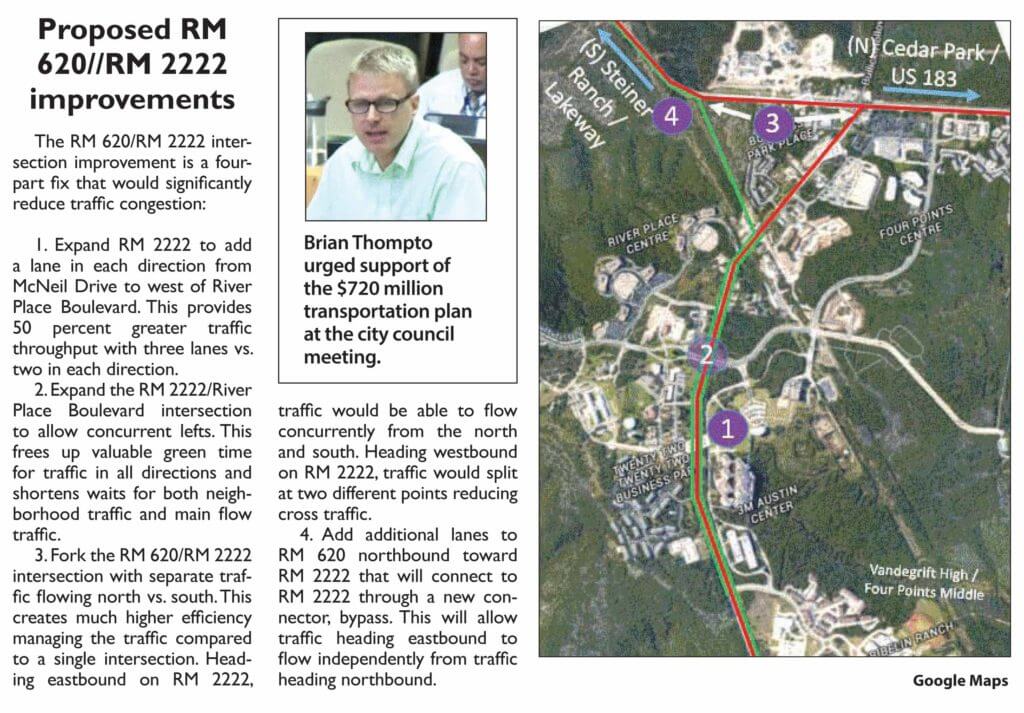By LYNETTE HAALAND, Four Points News
Last week the Austin City Council endorsed Mayor Steve Adler’s proposal to ask voters for permission to sell $720 million in property-tax-based bonds over the next five years, and parts of the plan include $101 million for projects that would help alleviate traffic congestion in Four Points.
“This (existing) congestion is dire for the community,” said Brian Thompto, local traffic relief advocate. “This is now a critical time for the West Austin – Four Points community to make sure our needs are heard and that the council takes very seriously the funding of improvements along RM 620.”
The transportation plan includes $101 million for “regional mobility improvements” including work on RM 620 and RM 2222, Loop 360, Anderson Mill and Parmer Lane. Many of these “regional” projects are outside of the city core and are included in Council Member Don Zimmerman’s District 6 and Council Member Sheri Gallo’s District 10. Both Zimmerman and Gallo voted for the plan.
Thompto was at the June 23 meeting and gave comments supporting the transportation plan for three minutes around 10:30 p.m. He emphasized the importance of including funding for fixing roadway bottlenecks such as RM 620/RM 2222.
The council vote was taken just after 1:30 a.m. on Friday and resulted in an 8-3 vote.
Calling this bond election will require another vote in August before it could be put on the November ballot. At the August meeting, the mayor and council will work on the language in the measure, decide on final funding allotments and which improvements are included.
Zimmerman believes that if the amount allocated is under a broad umbrella of “regional mobility”, then it is easier for the funds to go elsewhere. “I’m concerned there is not accurate ballot language,” he said.
Zimmerman is proposing when the city council goes to the voters with this bond, that amounts for specific projects are listed. An example may be $15 million for the RM 2222/RM 620 intersection improvements and connector road, and then a certain amount for Anderson Mill improvements and a certain amount for Parmer Lane improvements.
“We need specificity in the bond language. It has to be specific. If it is $100 million for ‘regional mobility’ projects, the answer is ‘absolutely not,’” Zimmerman said.
Another concern Zimmerman has about the plan is the amount of money seemingly allocated for non-road purposes that do not help alleviate congestion. “People are pretty angry about bike paths and trails,” he said, adding they’ll spend millions “on an urban trail to nowhere.”
Thompto is staying focused on the fact that this transportation plan is Four Points’ best opportunity to alleviate local congestion in the near future.
“Getting this measure on the ballot is a critical step to getting the RM 620/RM 2222 improvements done anytime soon,” said Thompto, director of community relations and mobility with the Four Points Chamber of Commerce and chairman of Steiner Ranch Neighborhood Association.
The ballpark estimate for RM 620/ RM 2222 intersection improvements is $25 million.
“This (transportation plan) would make a huge difference for getting this done within the next two or three years or getting it done eventually. The community cannot wait for eventually,” Thompto said.
The RM 620/ RM 2222 intersection improvements are important enough that Texas Department of Transportation and Travis County are looking at cooperative funding to get the project done. But both indicate they need the city of Austin to be the primary source of funding.
Thompto said that funding to get the work done is the biggest hurdle.
“The sooner we can identify funding, the sooner we can get this project built,” Thompto said. If funding is not identified soon, it could be five or more years before an opportunity comes up again, he added.
“It is critical the mayor understands that the 2222/620 project can be done quickly and that the city has to take the primary role to fund the project. He’s in charge of bucketizing the funds,” Thompto said.
He also believes that the city has an important role with this transportation plan opportunity.
“Not only should the city be the primary supporter of this but the city has a responsibility to solve this problem,” said Thompto.
He is urging the community to support this plan.
“We need the West Austin/Four Points community be energized around to helping get these projects funded,” Thompto said.
Residents can help:
• Contact CAMPO (another initiative to help draw awareness to the funding needs in Four Points) to express the importance of improvements along RM 620 and RM 2222. CAMPO is taking comments on such things until June 29, email campo@campotexas.org
• Before August, contact the mayor and city council members supporting the plan and ,allocations for projects specifically along RM 620. The email to send something to all members is: www.austintexas.gov/email/all-council-members or email them individually.
“The sooner the better because the conversations are happening now,” Thompto said.
If the transportation plan makes it to the November ballot and if voters pass it in November, the result would be a tax increase of 2.25 cents per $100 of taxable value, or $56 a year on a $250,000 home, and it would be phased in over five years.

